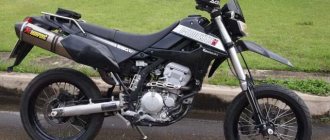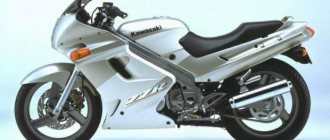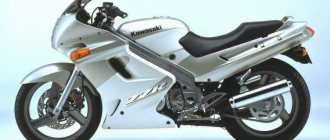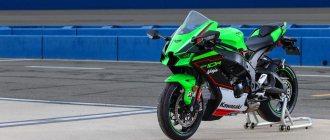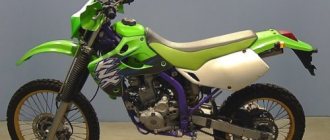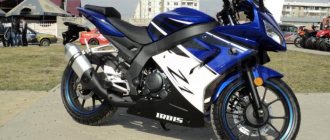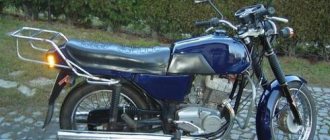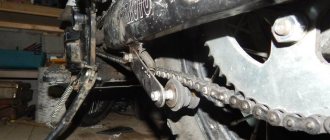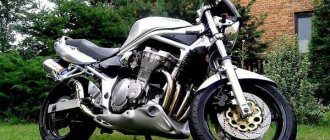Motorcycle history
The first model was released in 1998. Unlike many other motorcycles with a displacement of 250 cubic centimeters, Kawasakis are still being produced. The first versions were aimed at domestic use. Since 2003, the production of Japanese motorcycles has been moved to Thailand.
This model is a copy of the Kawasaki KLX 250, only with some modified parts. Powerful road wheels, brakes and a stiffer suspension replaced the previous ones. The fact is that the Kawasaki D-Tracker 250 belongs to the class of motards - motorcycles that are a cross between a cross-country motorcycle and a road motorcycle. Motards are considered an ideal means of transportation for Russian cities, as they have the lightness of cross-country bikes and the cross-country ability of road bikes.
The first series of Kawasaki D-Tracker came off the assembly line from 1998 to 2007, had an 8-liter fuel tank and 30 horsepower. An improved version went on sale in 2008. She had her carburetor and brake discs replaced. But the number of horsepower has decreased to 23. At the moment, the model is produced only on the Asian market; in Japan, production of the D-Tracker ceased in 2016.
It all happened last winter, when I realized: I want to open a category and drive a motorcycle.
The choice of model was not particularly pressing: I am a student, so all savings were limited to 130-140 thousand for a motorcycle and another 50 for equipment and putting the motorcycle in order, if necessary. And the motorcycle would be my first, so it was decided to choose from enduro or motards with 250 cc. They say this is just the thing for a beginner. Initially, I really wanted an enduro due to its greater versatility, I went to look at various Honda XR and Yamaha TTR (they were my favorites), and, of course, I also considered the Suzuki Djebel, but I didn’t need the huge volume of its fuel tank and did not suit me aesthetically. In the Yamaha TTR, I was put off by its age - the motorcycle would be almost my same age. I didn’t really want to consider the Kawasaki KLX because of the water cooling, which, it seemed to me, only complicates the design of the engine (and at the same time its maintenance) and reduces reliability.
In the Yamaha TTR, I was put off by its age - the motorcycle would be almost my same age. I didn’t really want to consider the Kawasaki KLX because of the water cooling, which, it seemed to me, only complicates the design of the engine (and at the same time its maintenance) and reduces reliability.
One day I came across a very good Honda XR in the R version that suited me (not the Baja), but I hesitated and it quickly went away. Then for a very long time nothing worthwhile came across, and I finally started looking towards the Kawasaki D-Tracker, since there was one very tasty offer, but very expensive. Time passed, I had almost completed training with an instructor in the month of April, and April had passed the middle, and I was still without a motorcycle. And suddenly I matured, because I realized that there was no point in waiting any longer: the season was starting, normal motorcycles would no longer appear, and if they did, it would be at an unaffordable price.
And then one extremely hot April day - the sun was hot, spring was literally felt everywhere - I stood at the bus stop, waiting for the minibus. That very expensive D-Tracker, which I finally decided to take a look at, was located somewhere outside the city, in a village near Moscow, so the path was not close.
He was exactly the same as in the photo in the ad. All yellow, very perky and bright, tall, with a sagging chain. The motorcycle, it seemed to me, was really excellent; the owner replaced the battery after hibernation and quickly started it. While the bike was warming up, I examined it, stubbornly pushing away thoughts of buying this miracle - after all, this thing was very much out of budget, at least 20 thousand. I myself was a little scared to get on someone else’s motorcycle (at that time I only had experience driving a training motorcycle), so I decided not to do a test drive. However, then I finally became convinced that the motorcycle was moving, and very briskly. Having finished the inspection and having agreed to call me if anything happened, I wandered to the bus stop. It was a long walk to get to it (let me remind you that it was in the Moscow region), so about five minutes later the owner caught up with me on a motorcycle and offered to give me a lift. Surprisingly , the yellow one pulled even two not very light men very quickly (to be honest, the dynamics seemed simple to me then hellish, it was very scary)
All yellow, very perky and bright, tall, with a sagging chain. The motorcycle, it seemed to me, was really excellent; the owner replaced the battery after hibernation and quickly started it. While the bike was warming up, I examined it, stubbornly pushing away thoughts of buying this miracle - after all, this thing was very much out of budget, at least 20 thousand. I myself was a little scared to get on someone else’s motorcycle (at that time I only had experience driving a training motorcycle), so I decided not to do a test drive. However, then I finally became convinced that the motorcycle was moving, and very briskly. Having finished the inspection and having agreed to call me if anything happened, I wandered to the bus stop. It was a long walk to get to it (let me remind you that it was in the Moscow region), so about five minutes later the owner caught up with me on a motorcycle and offered to give me a lift. Surprisingly , the yellow one pulled even two not very light men very quickly (to be honest, the dynamics seemed simple to me then hellish, it was very scary)
“Stop deluding yourself, this is my motorcycle. We must take it before it’s too late!” I told myself that evening. The motorcycle was indeed in good technical condition, as far as I could tell at the time. I was always more familiar with technology than with technology, but I had nothing to do with motorcycles, or with motor vehicles in general. However, this did not stop me from thoroughly preparing to check the technical condition of the future beast, for which I thank the Internet. So, I was almost completely sure of yellow, because... During the inspection, I checked everything in my power. I didn’t like the dead chain, but I didn’t care much about the consumables - this is a profitable business.
A week later I already became the owner of a fairly fresh Suzuki 250 SB 2004, produced in bright yellow. This is the same Kawasaki D-Tracker, only with the Suzuki inscription. As far as I understand, they have an agreement there: Kawa produced the KLX 400, which is actually the DR-Z 400, and Suzuki produced the Kawasaki Tracker. Since the bureaucracy had not been abolished, I did not yet have a license (I only managed to get the coveted card at the end of July), and the motorcycle spent the first half of the summer mostly in the garage. It’s worth noting that driving without a license is still an adrenaline rush. 
I'll start with the main thing: I wanted to buy an enduro, but I ended up buying a motard. And I don’t regret at all that this happened. The motard fits my usage scenario perfectly (almost): I need to quickly get to the university through traffic jams, get to the dacha (50 kilometers), go somewhere to relax and just enjoy the trip. In general, continuous asphalt operation. I go off-road extremely rarely, solely for the sake of pampering. The Motard is not very suitable for long-distance travel, since the narrow seat takes its toll (once, having traveled about 350 km in a day, my butt became truly iron), its lightness and low engine power are also inappropriate - on a spacious highway sometimes you want to push at least up to 150 -160 km/h, and my Kava begins to hum pitifully at about 130 km/h. I try not to torment it.
And I don’t regret at all that this happened. The motard fits my usage scenario perfectly (almost): I need to quickly get to the university through traffic jams, get to the dacha (50 kilometers), go somewhere to relax and just enjoy the trip. In general, continuous asphalt operation. I go off-road extremely rarely, solely for the sake of pampering. The Motard is not very suitable for long-distance travel, since the narrow seat takes its toll (once, having traveled about 350 km in a day, my butt became truly iron), its lightness and low engine power are also inappropriate - on a spacious highway sometimes you want to push at least up to 150 -160 km/h, and my Kava begins to hum pitifully at about 130 km/h. I try not to torment it.
The motorcycle is reliable. I won't be surprised by anything here. It works as it should and always starts. One day, however, a curious incident occurred. On a fine summer day I decided to take a ride to the region and ended up somewhere near the town of Vereya. Rolling quietly across the field along the road, he drove into a rut and fell on his side. The engine, of course, stalled. Having picked it up, adjusted the bag on the tank, I press the start button and... nothing. I twist the key and press the button again. My heart skipped a beat. “I’ve finished the game..,” I thought, “it won’t start!” It was 10-15 kilometers to the city, and 120 to the house, and I already began to realize the scale of the mess in which I found myself. But suddenly it dawned on me: the motorcycle was in gear! Garden head! I put it in neutral and drove on happy. My far-fetched fears about maintaining a water-cooled motorcycle were not confirmed. This does not cause any problems, and (as far as I understand) it provides more power compared to air vents of the same volume. I didn’t have many falls, and all at fairly low speeds, so the radiotor was not damaged.
The motorcycle is fast. At first it seemed a little too powerful, but as my driving skills improved, this feeling quickly disappeared. Of course, like on a holeshot or KTM, you won’t be able to spend all the time in a vertical position, but it’s easy to get away from a traffic light at the back (with the proper skill). It was possible to make the motorcycle even faster thanks to replacing the sprockets (I had to change them along with the chain, I was ready for this when purchasing), after replacing the sprockets from standard 14-39 teeth to 14-42, the dynamics increased noticeably, but the maximum speed did not decrease very much.
Servicing Kava is easy, which is important for a beginner. The oil here, unlike the same Honda XR, is poured directly into the crankcase, and not through the frame, so replacing it is extremely easy. You just need to unscrew the bolt on the bottom and remove the cover hiding the oil filter. One day one of the fork feathers became sniffy, which made me very sad. I understood that the oil seal needed to be changed, but I was very afraid to disassemble the unit - what if I couldn’t put it back together? Realizing that it was dripping just from the side on which the front brake is located, I watched a dozen videos about disassembling inverted forks, tried to visually remember everything and got started. I fussed about for about 5 hours and returned home happy, covered in fork oil. 
I don’t even know what else to add - the motorcycle is excellent and I really like it, it’s a real city traffic jam buster, on which you can also attach a bag and go on a not too far journey. True, without much comfort. It is this, as well as the realization that I want more power, that is forcing me to regretfully sell my yellow friend this winter and think about something more cubic in size. Naturally, this will also be a motard, because I’m not going to deny myself the pleasure of driving around a traffic jam on tram tracks, driving through the forest or stairs. Now I’m considering a Yamaha XT660X or a Suzuki DR-Z. Of course, I would like a Yamaha, as it is more comfortable and better suited for long trips.
True, without much comfort. It is this, as well as the realization that I want more power, that is forcing me to regretfully sell my yellow friend this winter and think about something more cubic in size. Naturally, this will also be a motard, because I’m not going to deny myself the pleasure of driving around a traffic jam on tram tracks, driving through the forest or stairs. Now I’m considering a Yamaha XT660X or a Suzuki DR-Z. Of course, I would like a Yamaha, as it is more comfortable and better suited for long trips.
Technical specifications Kawasaki D-Tracker 250
The Kawasaki 250 supermoto can leave a lot of pleasant impressions when riding on smooth asphalt or off-road. The single-cylinder engine provides good traction at low speeds. The declared engine capacity of 249 cubic centimeters produces speeds of up to 150 km/h. However, a comfortable speedometer reading fluctuates around 120-130 km/h.
17-inch wheels with reinforced brake discs bring the motorcycle to a stop in the shortest possible time. Smooth acceleration and confident speed maintenance are provided by 24 horsepower. The narrow chassis allows you to pass between cars in traffic jams without fear of catching them. The 9.1-inch rear wheel suspension provides a perfectly smooth ride. Even speed bumps will hardly be felt at high speed, despite the low seat position.
Liquid cooling of the engine reliably protects it from overheating, so even in hot weather you can safely move on the roads without fear of motorcycle breakdown. Six gears give you plenty of room to maneuver, and they shift very smoothly and easily. Manufacturers also took care of the durability of the bike: its aluminum cylinder has a special coating that ensures a tighter connection between the piston and the cylinder. Thanks to this trick, the service life of the engine is significantly increased.
There probably won’t be enough space for two on the motard, but one driver will be very comfortable on it. For long trips over 300 kilometers, the Kawasaki D-Tracker is unlikely to be suitable, but for this there are touring motorcycles with increased comfort.
The D-Tracker is the ideal first motorcycle. For beginners, the power hidden in the motard will be enough. Easy handling and excellent brakes will allow you to take your first steps on the spiritual wheel path. In an urban environment, it has no equal: it easily passes between cars and does not overheat in traffic jams.
Tuning
Tidying up a 2008 motard.
Tidying up a 2011 motard.
The first thing that needs tuning is a modernized wing. Although it looks stylish, there is almost no practical side to it.
In bad weather, raindrops from the wheel reach the top headlight, which is unaesthetically displayed on the appearance of the wing. The dashboard is illuminated in a beautiful blue hue at night.
The saddle is quite a “passable log”; you can ride alone quite comfortably and you can even “throw” a passenger a short distance.
It sits quite comfortably in the passenger seat. Due to the balanced center of gravity, the motorcycle behaves even more stable.
Engine cooling
It is worth paying attention to the liquid cooling system of the engine - it is so harmoniously designed that even in the heat the pilot can safely travel long distances . Although the motorcycle, in principle, is not intended for long-distance travel. The six-speed gearbox provides the ability to perform various maneuvers on the road.
Another positive point: manufacturers took care of increasing the service life of the aluminum cylinder. It is coated with a special compound that reliably protects it from damage and ensures a tighter adhesion of the piston to the cylinder.
Pros of a motorcycle
From a standstill, the D-Tracker does not reach 100 km/h. It starts smoothly, unhurriedly, but maintains a smooth, high speed. The dynamics of the motard deserve special praise: not every 250 cc motorcycle is capable of such agility. A good suspension smooths out road unevenness. At a speed of 130 km/h, you can easily jump over a speed bump without even noticing it. Since the bike's pedigree includes cross-country motorcycles, it can easily ride on dry ground and lightly rough terrain.
If we talk about repairs, they are not complicated: inexpensive spare parts can be found in almost every specialized store. Since this bike is purchased mainly by beginners, the plastic on it goes through severe tests, which, by the way, it withstands with dignity. Gasoline consumption is very economical, the tank lasts approximately 120-130 km.
Minuses
But the motard also has disadvantages. First of all, this is the low power of the motorcycle. Experienced drivers say that they lack acceleration speed. It reaches a maximum of 90 km/h on long trips. The motorcycle can accelerate to 130 km/h, but only on very short sections of the road. On the other hand, this very specific bike is designed for certain needs, and if you buy it for something other than its intended purpose (for example, for touring or racing on the track), it is foolish to expect good performance from it.
When buying a Kawasaki D-Tracker 250, you need to remember that it is not a real dirt bike. He will not drive through the mud, but will get stuck in it. Another disadvantage is the transportation of only one driver. You can seat a passenger, but it will be difficult to travel with him. In the Kawasaki 250, the seat is not designed for two people, and the bike will go much slower.
The Kawasaki klx 250 D Tracker will undoubtedly perform at its best if you clearly understand why you are purchasing it and for what purpose. It is ideal for beginners and lovers of small cubic capacity. Lightweight, maneuverable, powerful two-wheeled transport will be a reliable means of transportation. If you want to go 130 or more, it won't suit you.
Specifications
In terms of parameters, this Kawasaki motorcycle is modest. Like, perhaps, most supermotos (motards). But you shouldn’t treat this as a disadvantage. Anyone who needs more productive equipment will buy it. And this option is suitable for those who need a simpler and quieter car.
| Motor type | in-line, 1 stroke, 4 cylinders |
| Power | 30 hp |
| Torque | 25.5 Nm |
| Maximum speed | 145 km/h |
| Acceleration to 100 | 8 s |
| Fuel consumption per hundred | 4.5 l |
| Drive unit | chain |
| Transmission | six-speed |
| Frame | half-duplex steel |
| Rear suspension | pendulum, monoshock absorber, stroke 205 mm |
| Front suspension | inverted fork, 43 mm, 230 mm travel |
| Rear brakes | 1 disc, 220 mm, 1-piston caliper |
| Front brakes | 1 disc, 260 mm, 2-piston caliper |
In general, everything here meets the requirements of a leisurely ride in the city, or a semi-sporty ride over bumps. However, the latter should not be too large. The machine can handle a lot, but it's nowhere near the ideal off-road motorcycle.
Main competitors
Kawasaki has collaborated with the Suzuki brand, so motorcycles from these brands are not competitors. But Honda provides significant competition to the Kawasaki 250 D Tracker. The Honda CRF 250L is a major contender in the small-capacity motorcycle market. Despite the fact that both bikes come from Japan, their differences are quite significant.
The Honda enduro motorcycle is positioned as a means of transportation for every day. Designed as a counter to the popular D-Tracker 250, the Honda CRF 250L has very similar features. Tank volume is 7.7 liters, 1-cylinder engine with 4 valves and fuel injection. But why do some motorcyclists consider it more powerful than the Kawasaki?
It's all about the engine, which the Honda bike got from the legendary line of sports CBR motorcycles. The manufacturer derated it and reconfigured it for better traction from the bottom. That is why reviews from motorcycle owners say that the Honda is more powerful and controllable. But the appearance is much better on the Kawasaki D-Tracker 250. It is a real city slicker. Bright colors and powerful appearance make it a home on the streets of the metropolis.
History of changes
The bike has undergone almost no changes. The new D-Tracker 250 of the last years of production is almost no different from the equipment of twenty years ago. This is clear both from the characteristics and from the photo and video, where the motorcycle shows itself in approximately the same way as before.
The evolution of the model is as follows:
- In 2002, they began to produce, among other things, white versions.
- Since 2008, the second generation has been produced with a new design. The carburetor was replaced with an injector.
- As of 2021, the bike is no longer sold in Japan.
Not surprisingly, the car has undergone few changes. This motorcycle is originally built according to the concept and does not need to be changed. Perhaps the only significant change was the change from the carburetor to an injector, which, by the way, was perceived negatively by many.
Spare parts
Before buying any motorcycle, drivers ask themselves: is it difficult to find spare parts for it? This problem is very relevant, because... Many bikes are imported from abroad, so parts for them are not easy to find in Russia. How are things going with the Kawasaki brand D-Tracker 250?
Spare parts for this motorcycle can be easily found in almost any city in Russia, especially large ones. If for some reason the required part is not available in the service, you can order it from Asia or America. But there are always spare parts for the most common breakdowns.
Appearance
Like other motards, the main parts are open. It looks stylish when combined with a typical motocross bike frame. The wheels, of course, are spoked, not cast, because the engine is not particularly strong and the motorcycle does not need extra weight.
The original white color of the main part of the frame goes well with the black color of the seat and metal parts.
The headlight at the front is small and square. The Kawasaki D-Tracker 250 is distinguished by large rounded mirrors that are located high. This is convenient given the fact that on such bikes you usually don’t have to bend down much, and they are not designed for this in principle.
Kawasaki D-Tracker 250: reviews
How do its owners respond to the motorcycle? Reviews about the Kawasaki 250 can only be found positive. It is called an excellent city motorcycle for beginners. It is easy to control and maneuverable, so it will be an excellent start for beginner motorcyclists. And an excellent braking system, which instantly stops the bike even at high speed, will protect you from collisions and accidents.
Owner reviews of the Kawasaki D-Tracker 250 also confirm that the bike has good cross-country ability: it can easily travel off-road. And if you swap the standard wheels for wide cross-country ones, the motard will be able to overcome difficult terrain.
Among the disadvantages, owners note the power, which ceases to be enough in the second year, and the slight acceleration of the motorcycle. Comfortable driving is possible at speeds up to 80 km/h. Riding the Kawasaki D-Tracker 250 on the track is almost impossible due to the wind, which blows the bike to the side. At speeds above 100 km/h it becomes very unstable.
Dimensions and weight
The dimensions of the model are similar to cross-country versions. This makes the D-Tracker 250 capable of handling light off-road conditions well. It is not capable of anything else simply because the technical characteristics of the motor are rather weak.
The dimensions of this motorcycle are as follows:
- height – 1175 mm;
- width – 790 mm;
- length – 2065 mm;
- wheelbase – 1435 mm;
- seat height – 865 mm;
- ground clearance - 226 mm;
- curb weight – 128 kg;
- Tank capacity – 8 l.
The bike weighs more than many motocross bikes. This, along with a weak engine, will make it less competitive in competitions of one nature or another. For those who want to travel long distances on such a bike, it is important to remember that its tank capacity is small and it is important that you meet a gas station on time along the way.
Results
The Kawasaki D-Tracker 250 is a great motorcycle if you know exactly why you are buying it. It is one hundred percent suitable for beginners and lovers of enduro bikes. Reliable, with a thoughtful design and excellent technical characteristics, it will serve its owner for many years. And the low cost makes it very affordable. Many people use it to perform various tricks: the low weight makes the Kawasaki D-Tracker very maneuverable.
But you shouldn’t place unreasonable hopes on him. The bike is not capable of long trips and will not compete with road or sports motorcycles. The Kawasaki D-Tracker 250 is a great bike for getting around the city.
Who is D'tracker 250 suitable for?
For oldies and motorcycle ladies, as well as for beginners who are just mastering the technique of this category.
The motorcycle seat is straight, without leaning forward or touristy “relaxation”, setting you up for active riding.
Thanks to its small cubic capacity and the necessary stability, the D-Trucker prevents bad thoughts from a crazy head from becoming reality. Although, as they say, there would be a desire. However, the motard is an excellent option for those who are looking for an easy-to-use and convenient vehicle that will not allow you to spend a lot of time in traffic jams.
Even a child can ride a motorcycle. In an urban environment, this moto has no equal. Therefore, we can say with confidence that the Kawasaki D Tracker 250 is an excellent trainer for the first steps on the two-wheeled path .
